

What is a fronted adverbial? FREE word mat & worksheets
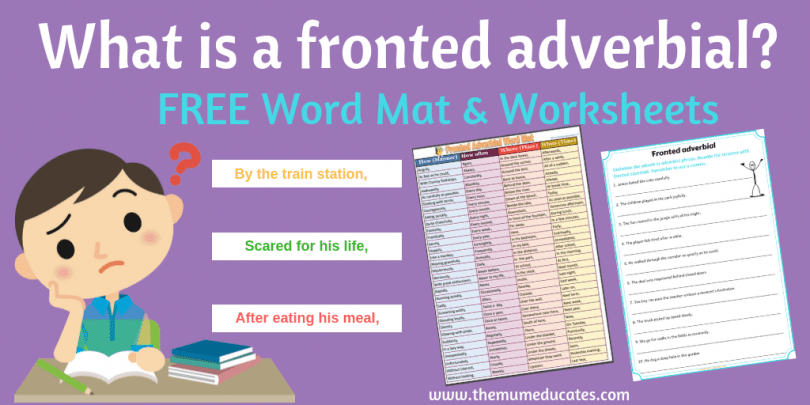
A fronted adverbial is a great way to up-level your child’s writing. Our engaging and colourful worksheets plus word mat have been designed to make the learning easy and interesting for all children.
What is an adverbial?
An adverbial is a word, phrase or clause which adds more detail or information to a verb e.g the time, place, or manner of which describe the action in the rest of the sentence.
- He drove to the hospital as quickly as he can .
- The children jumped happily .
- I met my friend in Paris.
- My daughter finished her work at half-past six .
Fronted adverbial definition:
A fronted adverbial is an adverbial phrase or a word that’s moved to the beginning of the sentence, before the verb. They are usually separated from the rest of a sentence with a comma.
So an adverbial phrase is an adverb, followed by a comma, followed by the main clause.
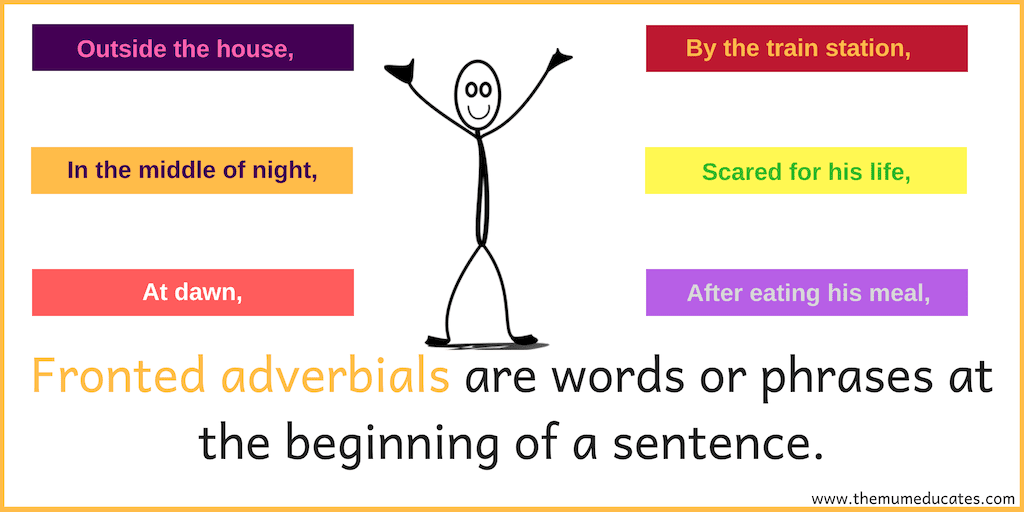
The fronted adverbial describes the action that follows. For example:
“The child opened the door” is an action. The fronted adverbial is “slowly”. So the action is going to be done slowly.
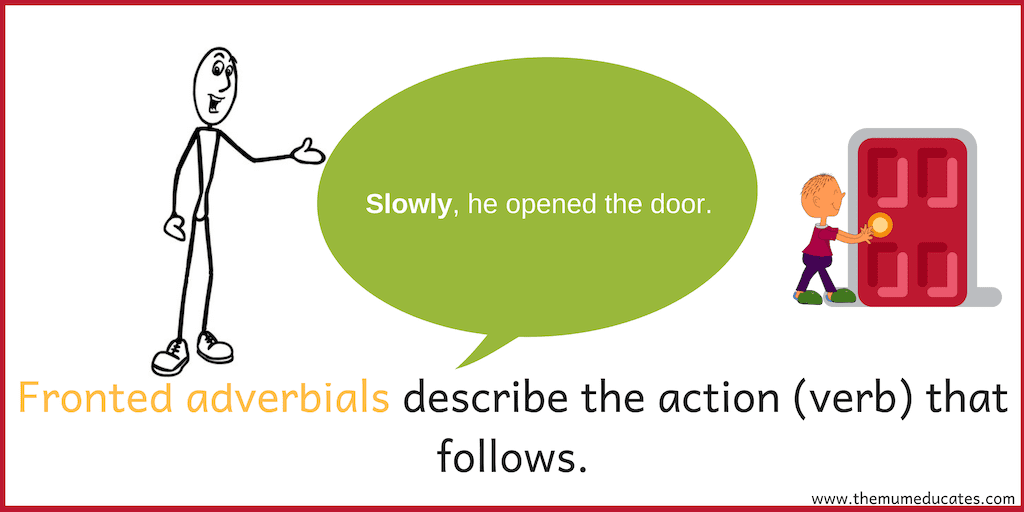
These adverbials help the child to improve their writing style. In order to make a complex sentence, the child can use coordinating conjunctions
Fronted adverbials examples.
Occasionally, my mum allows me to have a sleepover at my friend’s house. (frequency)
In the distance, he could hear a scream. (Where)
Carefully, Ben read the recipe. (How)
In the garden, there was a baby hedgehog under the leaves. (Where)
As soon as he could, He left the exam hall . (When)
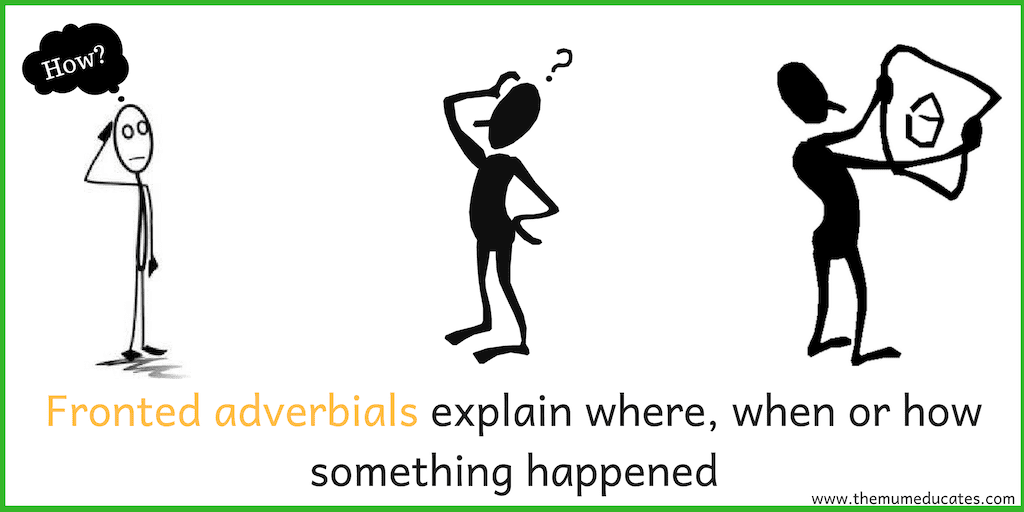
How to teach fronted adverbials in a fun way?
A great resource for KS2 children to keep on hand as a prompt and spelling reference during independent writing tasks.
Our wonderful fronted adverbial word mat will make it easy for your child. Firstly, ask your child to write a few simple sentences like:
- She ran to the school.
- Ben ate ice cream.
- Tom finished his homework.
Now ask your child if they can improve these sentences using the given fronted adverbials word mat . Try to do the same thing over an over again to make them learn better.
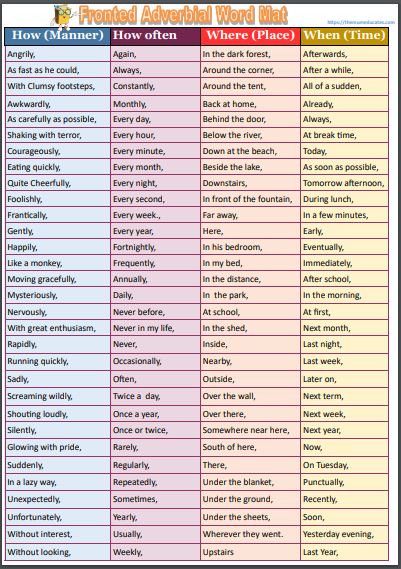
Spot an adverbial phrase or adverbs
Please also have a look at our free prefix and suffix mats , which can help the child to get better in spellings.
In the fronted adverbials worksheet , read the sentence and spot the adverb or adverbial phrase. Move them at the start of the sentence to make the fronted adverbial sentences. Remember your child to add a comma after the fronted adverbial phrase or word.
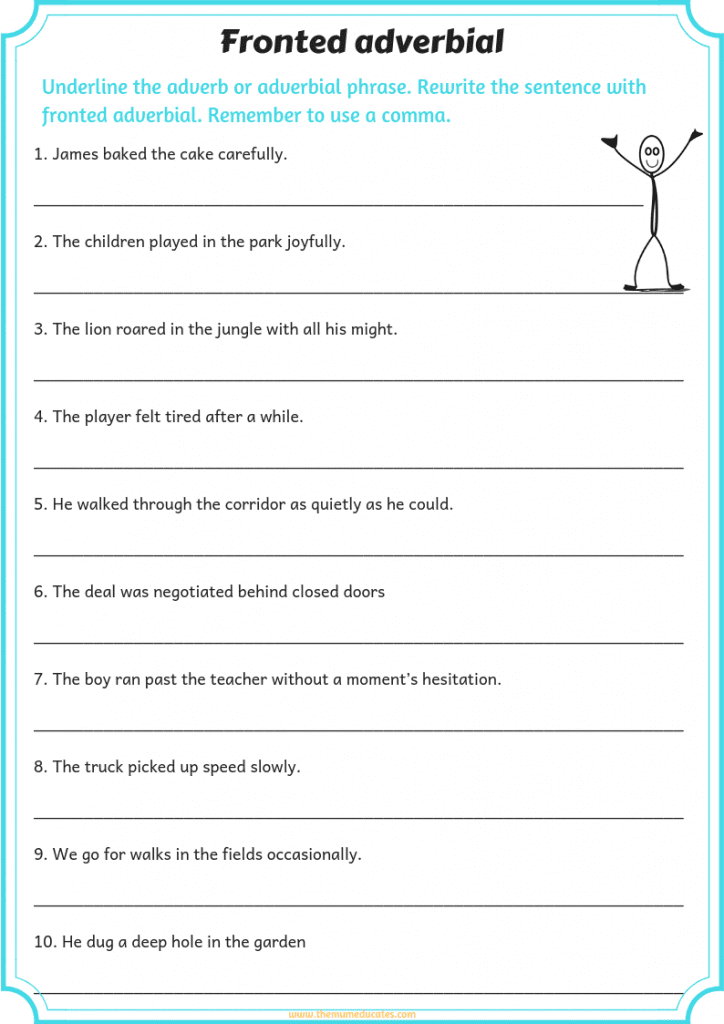
Make sentences with fronted adverbials.
Show the pictures below to the children and ask them to write a fronted adverbial sentence for each picture. An example sentence has been provided under each picture.

Slowly , the bird soared across the sky.

At midnight , the fairies danced above the glistening sky.

Attentively , the children listened to the story.

Slowly , the children crossed the road.
If you are interested in some creative writing story starters for children, please have a look at 21 Creative writing story starters for children
For more wonderful books and resources visit our store.

Share this post: on Twitter on Facebook on Google+
You may also like
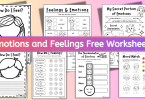
Emotions and Feelings Worksheets – FREE
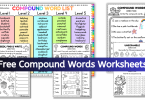
Free Compound Words List and Worksheets
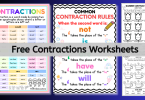
Contractions in Grammar Worksheets – FREE
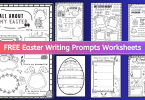
Free Easter Writing Prompts for Kids
To explore fronted adverbials
Lesson details, key learning points.
- In this lesson, we will be learning about fronted adverbials of time, place and manner. We will also practice writing some sentences with fronted adverbials.
Content guidance
- Contains depictions of discriminatory behaviour.

Supervision
Adult supervision suggested
This content is made available by Oak National Academy Limited and its partners and licensed under Oak’s terms & conditions (Collection 1), except where otherwise stated.
Lesson appears in
Unit english grammar / t1: sentence level objectives, english grammar, unit english / the windrush - diary writing.
- International
- Education Jobs
- Schools directory
- Resources Education Jobs Schools directory News Search

Fronted Adverbials
Subject: English
Age range: 7-11
Resource type: Worksheet/Activity
Last updated
19 March 2021
- Share through email
- Share through twitter
- Share through linkedin
- Share through facebook
- Share through pinterest

Creative Commons "NoDerivatives"
Your rating is required to reflect your happiness.
It's good to leave some feedback.
Something went wrong, please try again later.
noorthetutor
Great resource. Thanks for sharing.
Thank you for taking the time to leave a rating. It is greatly appreciated.
Thank you for taking the time to leave a rating. It is greatly valued.
Empty reply does not make any sense for the end user
Exactly what I needed, thank you.
Thank you for taking the time to review this resource. It is greatly appreciated.
Superb resources. Thank you soo much.
epdemetriou
Thank you for sharing.
Thanks for sharing
Thank you for taking the time to leave a rating for this resource. It is greatly appreciated.
Report this resource to let us know if it violates our terms and conditions. Our customer service team will review your report and will be in touch.
Not quite what you were looking for? Search by keyword to find the right resource:

Athelney Primary School
Success for today; prepared for tomorrow. Nothing is beyond our reach.
- Fronted Adverbials
- Class Pages
- Class Pages Archive: 2019 - 2020
- Gemini Class Year Three
- Spelling and Grammar
- t2-e-3215-fronted-adverbials-ks2-what-is-a-fronted-adverbial-powerpoint-_ver_8.ppt
Printables / activities for fronted adverbials
- 1 How Did It Happen.pdf
- 1 When Did It Happen.pdf
- 1 Where Did It Happen.pdf
- 2 Adverbial Sort.pdf
- 3 Spot the Adverbial.pdf
- 4 Spot the Missing Comma.pdf
- 5 Fronted Adverbials Writing Prompt.pdf
- 5 uplevelling-sentences-activity-sheets.pdf
- WORD MAT fronted-adverbials-ks2-word-mat-list-_ver_6.pdf
Unfortunately not the ones with chocolate chips.
Our cookies ensure you get the best experience on our website.
Please make your choice!
Some cookies are necessary in order to make this website function correctly. These are set by default and whilst you can block or delete them by changing your browser settings, some functionality such as being able to log in to the website will not work if you do this. The necessary cookies set on this website are as follows:
Website CMS
A 'sessionid' token is required for logging in to the website and a 'crfstoken' token is used to prevent cross site request forgery. An 'alertDismissed' token is used to prevent certain alerts from re-appearing if they have been dismissed. An 'awsUploads' object is used to facilitate file uploads.
We use Matomo cookies to improve the website performance by capturing information such as browser and device types. The data from this cookie is anonymised.
Cookies are used to help distinguish between humans and bots on contact forms on this website.
Cookie notice
A cookie is used to store your cookie preferences for this website.
Filter year:
Recognising Fronted Adverbials 1 Modelling PPT

Do you need a set of questions for children to test out their adverbial knowledge? Look no further than this Year 4 Recognising Fronted Adverbials 1 Modelling PowerPoint. This slide show includes a range of varied fluency, reasoning and application questions to share with your class and model how to answer them. This is a great introduction to some of our question styles that they might encounter within the accompanying resources for this lesson.
Use this in your lesson introduction as your main teaching tool. It can be a great opportunity to address any misconceptions and recap how to spot an adverbial phrase. You could also display the questions on screen for children to answer as an extension task or to wrap up your lesson.
Curriculum Objectives
- Develop their understanding of the concepts set out in English appendix 2 by: Using fronted adverbials / Indicate grammatical and other features by: Using commas after fronted adverbials / Fronted adverbials [for example, Later that day, I heard the bad news.] / Use commas after fronted adverbials
More like this

More Y4 resources


IMAGES
VIDEO
COMMENTS
A fronted adverbial is a word, phrase, or clause that is used, like an adverb, to modify a verb or a clause. Adverbs can be used as adverbials, but many other types of words, phrases, and clauses can be used in this way, including prepositional phrases and subordinate clauses. Basically, fronted adverbials are phrases or words at the start of a ...
Year 4 Fronted Adverbial Games Activity Pack. 5.0 (2 reviews) Prepositional and Adverbial Phrases Presentation. 4.8 (24 reviews) Fronted Adverbials KS2: Features of Sentences Display Pack. 4.5 (10 reviews) KS2 Commas After Fronted Adverbials Worksheets. 4.8 (8 reviews) KS2 Fronted Adverbials of Manner Activity Pack.
Welcome to our lovely collection of fronted adverbial resources for Year 3 and Year 4 pupils. Here you'll find everything you need to teach children how to identify a fronted adverbial in a text and how they can correctly use them in their own writing. This includes informative PowerPoint presentations, engaging worksheets, and attention ...
Give your class another opportunity to put their knowledge of adverbials into practice with this Year 5 Fronted Adverbials Homework resource. Children are faced with two varied fluency questions and a reasoning question to complete. This resource has three levels of differentiation that offer you both choice and challenge for your class.
A fronted adverbial is an adverbial phrase or a word that's moved to the beginning of the sentence, before the verb. They are usually separated from the rest of a sentence with a comma. So an adverbial phrase is an adverb, followed by a comma, followed by the main clause. The fronted adverbial describes the action that follows.
KS2 Resources & Worksheets > KS2 Vocabulary, Spelling, Punctuation & Grammar Resources & Worksheets > Resources and Worksheets. ... Year 4 Using Fronted Adverbials Homework Extension provides additional questions which can be used as homework or an in-class extension for the Year 4 Using Fronted Adverbials Resource Pack and are differentiated ...
This KS2 teaching resource introduces pupils to using fronted adverbials and how they can improve our writing skills. Content includes: Adverbs recap with an activity. A fronted adverbial explanation. Why we use fronted adverbials in our writing explanation. Activities to support the teaching of these objectives with 2 accompanying worksheets.
Fronted adverbial - a sentence starter followed by a comma. Comma - a punctuation mark used after any fronted adverbial. Phrase - a group of words with no verb. Manner - the way in which a verb is done. Throughout the lesson, gather examples of each form (word and phrase) and type (manner, place, time) so that pupils have plenty of ideas ...
A fronted adverbial is a sentence starter followed by a comma that expresses detail about time, place, manner or cause. A fronted adverbial can be a single word, phrase or clause. A clause is a group of words that contains a verb. A phrase is a group of words with no verb. A variety of fronted adverbials are useful to achieve text flow.
Get your class prepared for using adverbials at the beginning of sentences with this Year 5 Fronted Adverbials Prior Learning worksheet. This resource includes three varied fluency questions, two application questions and a reasoning question.
To explore fronted adverbials. Download all resources. Share activities with pupils. Slide deck. Lesson details. Video. Slide deck. Download slide deck. Skip slide deck. Lesson details. Key learning points. In this lesson, we will be learning about fronted adverbials of time, place and manner. We will also practice writing some sentences with ...
This is an editable, 50-slide PowerPoint lesson on fronted adverbials. The PowerPoint includes: a recap of adverbs. adverbial phrases of time, place, manner and frequency. fronted adverbials. insertion of the comma after fronted adverbial. opportunities for pupils to identify adverbs, adverbial phrases and fronted adverbials.
1 When Did It Happen.pdf. 1 Where Did It Happen.pdf. 2 Adverbial Sort.pdf. 3 Spot the Adverbial.pdf. 4 Spot the Missing Comma.pdf. 5 Fronted Adverbials Writing Prompt.pdf. 5 uplevelling-sentences-activity-sheets.pdf. WORD MAT fronted-adverbials-ks2-word-mat-list-_ver_6.pdf. Athelney Primary School.
Children can continue to apply their knowledge and understanding of adverbials at home with this Year 4 Recognising Fronted Adverbials 1 Homework resource. There's no need to worry about creating differentiated versions as we have you covered with three levels of challenge. This ready-to-complete resource includes two varied fluency questions ...
In this Year 5 Fronted Adverbials Application worksheet children are challenged to continue an adventure story including sentences using different adverbs and adverbials in varying positions. The story opener provided allows children to focus on using adverbials without having to focus on the initial context for the story.
This Year 5 Fronted Adverbials Mixed Activity contains a range of varied fluency reasoning and application questions. Children will be challenged on their understanding of fronted adverbials and how to use commas with them accurately. An answer sheet has been provided for quick and easy marking, or it could even be used for peer and self marking.
Develop their understanding of the concepts set out in English appendix 2 by: Using fronted adverbials / Indicate grammatical and other features by: Using commas after fronted adverbials / Fronted adverbials [for example, Later that day, I heard the bad news.] / Use commas after fronted adverbials
Do you need a set of questions for children to test out their adverbial knowledge? Look no further than this Year 4 Recognising Fronted Adverbials 1 Modelling PowerPoint. This slide show includes a range of varied fluency, reasoning and application questions to share with your class and model how to answer them.